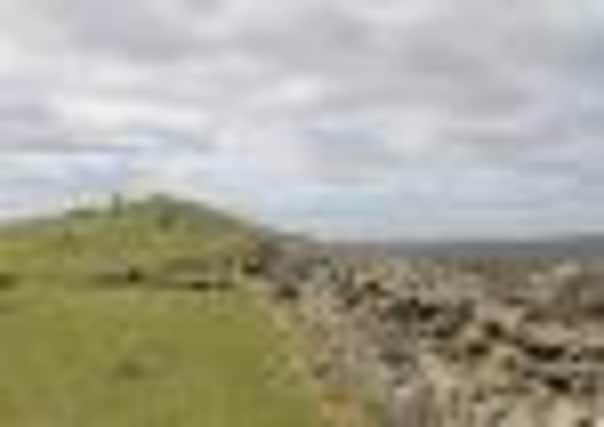The roof of England


ONE of the great delights of the English countryside is the patchwork of ancient footpaths and rights of way which criss-cross the rich landscape and reveal the history for which this island is famed.
And there can surely be no more evocative route than the path of Hadrian’s Wall, winding its way across 84 miles of England up hill and down dale, from sea to freezing sea.
Advertisement
Hide AdAdvertisement
Hide AdTo walk this path is to follow in the footsteps of centurions who spent so many years constructing and then patrolling this feat of engineering. This is no ordinary walk. Each footstep seems to be accompanied by the clink of Roman armour, each sweeping panorama electrified by the image of hoards of raiding Celts upon the horizon.
A coast-to-coast march sounds a little daunting but bear in mind that Hadrian was no mug. He built his wall at what is one of England’s narrowest points.
Just as importantly, each of our six days’ walking and each of our seven nights’ accommodation – not to mention the daily baggage transfers were carefully planned, meaning we set off each morning in the knowledge that the distance ahead would never be too arduous and that our bags would be waiting in a comfy B&B that evening.
The start is somewhat inauspicious, a day-long urban trek from the mouth of the River Tyne where the original wall is little in evidence. It takes you along the riverside on a fascinating journey through the dilapidated shipyards and disused tar-works.
Advertisement
Hide AdAdvertisement
Hide AdSuddenly we emerge blinking into 21st century quayside, a stunningly rejuvenated city centre waterfront where bars and cafes bustle alongside water fountains, overlooked by magnificent arts centres and the line of bridges which tower above the Tyne.
Then we are out into the suburbs, and slowly the houses become fewer and the fields more plentiful. We re-join the river for a stretch before the ground starts to rise and the uplands are before us.
There are brief glimpses of the original wall here and there, but much of it has long been buried beneath an old military road following an impressively carefree act of 18th century desecration.
General George Wade decided in his wisdom that the wall would make an excellent thoroughfare upon which to mobilise troops against the renewed Jacobite threat from the North. A long section was knocked down and its stones used to create a road for his armies, now known as the B6318, but still shooting as straight as an arrow from east to west.
Advertisement
Hide AdAdvertisement
Hide AdWe follow it for several miles in footways that wind through the deep ditch dug by Hadrian’s men, passing clumps of yellow primroses blinking timidly in the early season sun and watching butterflies flicker among the wildflowers.
The joy of this walk is to watch the landscape change with every western step, and as we enter the third day the world is becoming bleaker, wilder, tougher to climb. Suddenly the original wall erupts from the earth and we find ourselves following it across the soaring Pennines from turret to milecastle, from look-out point to ancient fort.
The ruins are impressive along this stretch and you can stand upon the wall and look out to the North, picturing those shivering soldiers watching for raiding Scots. This section of the walk is England at its most magnificent.
After two days of wonderful hilltop walking we find the inclines becoming gentler and it is clear we have passed the watershed. The springs now flow westward with us towards the Irish Sea.
Advertisement
Hide AdAdvertisement
Hide AdThe hills give way to lush green Cumbrian farmland and we are trekking along spiky hedgerows, newborn calves stuttering in the fields as protective mothers glare from behind rusted gates.
To the south the glorious peaks of Skiddaw, Blencathra and Ullock Pike tower above the northern lakes; to the north snow-tipped Scottish mountains lurk in the distant gloom. We pass through Carlisle on our fifth night and join the River Eden as it heads westward out towards the firth of Solway. It’s a struggle through the final few miles across bleak saltflats where a bitter wind whips in from across the border.
Finally we arrive, aching but triumphant, at the tiny village of Bowness-upon-Solway, where the Romans decided the estuary was too wide for the hoards to cross so the wall could end. We wander out onto the sandflats and run our hands through this western sea, minds cast back to the distant east coast we left behind one week earlier and all that stands between.
Getting there
Jack Blanchard’s trip was arranged by York-based Discovery Travel, which offers a range of self-guided walking and cycling holidays across Britain, Ireland and parts of Europe. Maps, guide books, detailed itineries, expert advice, bed-and-breakfast accommodation, luggage transfers and emergency support are all provided as part of each package.
Advertisement
Hide AdAdvertisement
Hide AdA seven-night self-guided walk along Hadrian’s Wall from Wallsend to Bowness-upon-Solway with Discovery costs £475 per person, based on two people sharing. For more information visit www.discoverytravel.co.uk; call 01904 632226 or email [email protected].